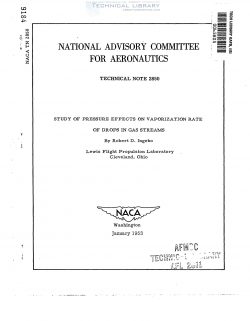naca-tn-2850
- Version
- 62 Downloads
- 1.12 MB File Size
- 1 File Count
- January 20, 2017 Create Date
- January 20, 2017 Last Updated
National Advisory Committee for Aeronautics, Technical Notes - Study of Pressure Effects on Vaporization Rate of Drops in Gas Streams

Numerous investigations have been made to determine the effect of
pressure on the vaporization rate of droplets in still air (refer—
ences l to 4). However, at present, vaporiZation—rate data, which show
the effect of pressure on the evaporation rate of drops in streams of
air or other gases, are unavailable. Since combustion-chamber pressures
of 1/3 to 4 atmospheres may be encountered in the operation of Jet
engines, the effect of air—stream pressure on the vaporization rate of
erl droplets is of considerable importance in the study of combustible
erl vapor and air nfixtures for jet combustors. Such mixtures are gen-
erally formed by the injection of fuel droplets at a point upstream of
the combustion zone. Thus, the concentration of fuel vapor in the mix-
ture entering the burning zone is determined by the vaporization rate
of the droplets. In order to determine this rate in air streams of
varying pressure, an investigation was made at the NACA Lewis laboratory
in which a range of pressure conditions encountered in aircraft combus-
tion systems was studied.
In reference 5, an equation is presented for simultaneous heat and
mass transfer which showed the effect of molecular mass transfer and
turbulent momentum transfer on the heat—transfer coefficient. This
heat-balance equation may'be used to predict the effect of drop diam-
eter, fluid velocity, and temperature on vaporization rates. However,
since the equation was determined for an air—stream pressure of
740 millimeters of mercury, it cannot be applied directly to vaporiza—
tion at different air—stream pressures. The present report was there—
fore prepared as an extension of reference 5.
The vaporization rates of pure liquids in gas streams having static
pressures of 450 to 1500 millimeters of mercury were determined for
single constant—diameter drops simulated by wetted porous spheres. The
experiments were conducted in air streams under the conditions of con—
stant fluid velocity with varying pressure and mass—flow rates, constant
pressure with varying velocity and mass-flow rates, and constant mass-
flow rates with varying pressure and air—stream velocity. The mass-
flow rate of air was varied over a Reynolds number range of 1560 to
5400 based on drop diameter, and surface-temperature data were obtained
in all tests. A limited number of experiments were also made in streams
of helium, argon, and carbon dioxide at constant pressure and varying
mass-flow rates.
| File | Action |
|---|---|
| naca-tn-2850 Study of Pressure Effects on Vaporization Rate of Drops in Gas Streams.pdf | Download |

Comment On This Post